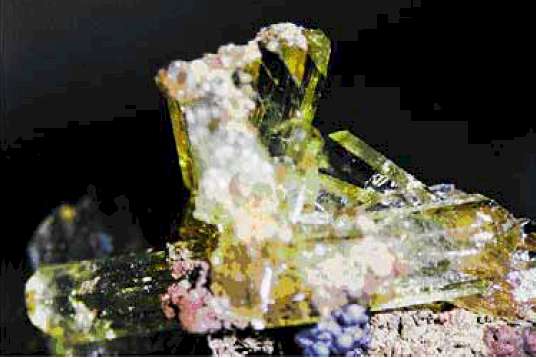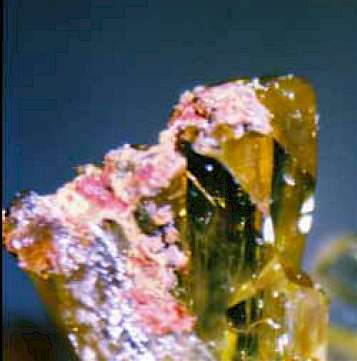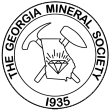Legrandite
by
Dave Babulski, Ed.D.
("Tips and Trips",Volume XXXV/Two February 2006, Page 8-9)
Greetings everyone; this month I would lke to highlight one of my favorite micro mineral subjects, the mineral legrandite. Chemically this mineral is a hydrated zinc arsenate hydroxide. The type locality for this mineral is the Flor de Pena Mine, Lampazos, Nueva Leon, Mexico. Current thinking is that legrandite forms under very special conditions by the action of arsenic bearing secondary solutions on weathering zinc deposits. This is a rare mineral being found in only a few localities in the world. Legrandite is highly sought after by collectors of micro minerals because of its beautiful straw yellow color and well formed prismatic crystals. Shown below is a photomicrograph of legrandite on matrix from the Ojuela Mine, near Mapimi, Durango, Mexico. Notice the Monoclinic prismatic 2/m crystal habit with the wedge shaped crystal terminations. (Photomicrograph at 25X with 4 second exposure on ASA 400 film.)
Legrandite is named after the Belgian mining engineer, Mr. Legrande. The mineral appears in several crystal habits ranging from slender acicular prismatic crystals to the large prismatic crystals with wedge shaped terminations shown in the above photomicrograph. Good specimens of legrandite are hard to come by on the collector market. Be prepared to pay a princely sum for good specimens. One of the interesting aspects of legrandite is the prevalence of sub faces on crystals. In the photomicrograph shown below a small crystal below the two large wedge shaped crystal terminations. This smaller crystal shows some of the smaller facets on the crystal termination. (Photographed at 50X with a 4 second exposure on ASA 400 film.
I have found that Legrandite specimens from the Ojuela Mine near Mapimi, Durango, Mexico yield the best transparent “gemmy” crystallized specimens. I have purchased Legrandite specimens from a number of mineral dealers. Another interesting aspect of Legrandite specimens from the Ojuela Mine is the complex vuggy matrix on which the crystals are formed: A complex combination of tubes, stringers and botryoidal masses with a mind blowing combination of pinks, browns and yellows. Sometimes I think the matrix is almost as interesting as the mineral crystals. Countless enjoyable hours can be spent exploring the miniature world under the microscope with the Ojuela Mine specimens. It is fun sometimes to imagine that you have shrunk down to a size that would fit on the specimen and are literally "walking the specimen". I would be interested in hearing of your own adventures when exploring the miniature worlds of micro-minerals. Until next month, may all your skies be blue and all your vugs be crystal filled.
References:
Dana, E.S., A Textbook of Mineralogy, John Wiley & Sons, Inc, New York, Fourth Edition, Pages 390 - 392.
Grafe, Markus; Nachtegall, Maartin and Sparks, Donald,
Formation of Metal-Arsenate Precipitates at the Goethite-Water Interface, Environ. Sci. Technol., 2004, 38, 6561 – 6570.
Lindgren, W., Mineral Deposits, McGraw-Hill, New York, Second Edition, Pages 99; 871-874.
Internet References:
http://webmineral.com/data/Legrandite.shtml
http://www.mindat.org/min-2365.html
http://www.xtal-dbeals.com/Ojuela_2.htm
http://10.1911encyclopedia.org/M/MI/MINERAL_DEPOSITS.htm


Legrandite is named after the Belgian mining engineer, Mr. Legrande. The mineral appears in several crystal habits ranging from slender acicular prismatic crystals to the large prismatic crystals with wedge shaped terminations shown in the above photomicrograph. Good specimens of legrandite are hard to come by on the collector market. Be prepared to pay a princely sum for good specimens. One of the interesting aspects of legrandite is the prevalence of sub faces on crystals. In the photomicrograph shown below a small crystal below the two large wedge shaped crystal terminations. This smaller crystal shows some of the smaller facets on the crystal termination. (Photographed at 50X with a 4 second exposure on ASA 400 film.
I have found that Legrandite specimens from the Ojuela Mine near Mapimi, Durango, Mexico yield the best transparent “gemmy” crystallized specimens. I have purchased Legrandite specimens from a number of mineral dealers. Another interesting aspect of Legrandite specimens from the Ojuela Mine is the complex vuggy matrix on which the crystals are formed: A complex combination of tubes, stringers and botryoidal masses with a mind blowing combination of pinks, browns and yellows. Sometimes I think the matrix is almost as interesting as the mineral crystals. Countless enjoyable hours can be spent exploring the miniature world under the microscope with the Ojuela Mine specimens. It is fun sometimes to imagine that you have shrunk down to a size that would fit on the specimen and are literally "walking the specimen". I would be interested in hearing of your own adventures when exploring the miniature worlds of micro-minerals. Until next month, may all your skies be blue and all your vugs be crystal filled.
References:
Dana, E.S., A Textbook of Mineralogy, John Wiley & Sons, Inc, New York, Fourth Edition, Pages 390 - 392.
Grafe, Markus; Nachtegall, Maartin and Sparks, Donald,
Formation of Metal-Arsenate Precipitates at the Goethite-Water Interface, Environ. Sci. Technol., 2004, 38, 6561 – 6570.
Lindgren, W., Mineral Deposits, McGraw-Hill, New York, Second Edition, Pages 99; 871-874.
Internet References:
http://webmineral.com/data/Legrandite.shtml
http://www.mindat.org/min-2365.html
http://www.xtal-dbeals.com/Ojuela_2.htm
http://10.1911encyclopedia.org/M/MI/MINERAL_DEPOSITS.htm



Copyright © Georgia Mineral Society, Inc.
